
Greetings, Cicada fans!
My goal is to capture every stage of the life cycle during this Brood XIX emergence.
Hatchings are the next step, but till then, here goes…
Let’s meet a periodical cicada.
This cicada is 13 years old:
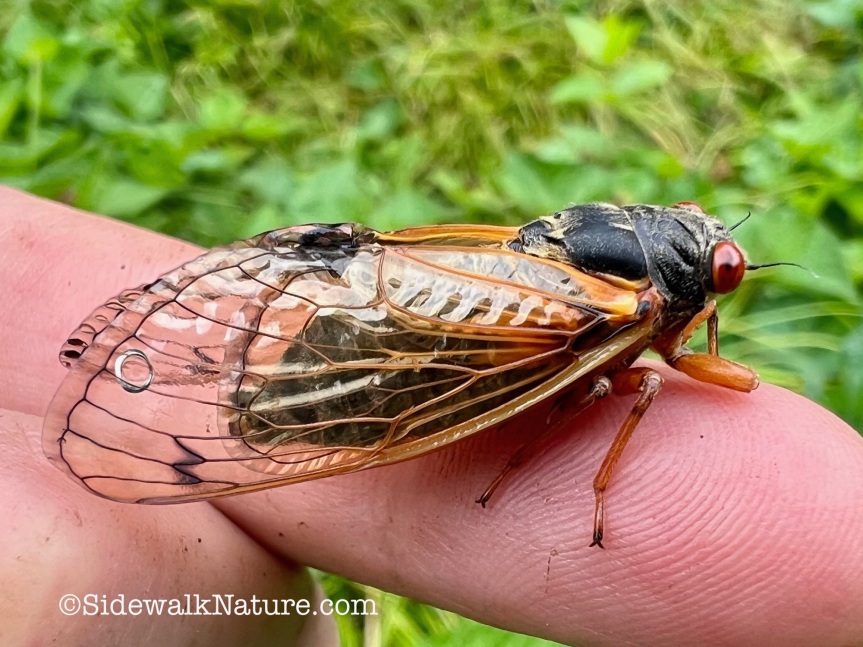
His story:
13 years ago, his mom laid an egg in twig in a tree. Six weeks after that, the eggs hatched, the new nymphs fell to the soil, found a crack, and burrowed inside to suck on tree rootlets.
For 13 years he and his siblings ate, peed, grew. They wriggled out of their skins four times before their final outfit, which included brand new accessories: wings.
**If the tree is cut down during the 13-years, the cicadas will not survive.**
After nearly 13 years, our cicada prepped for his final molt in spring. Prep = black spots, red eyes.
According to Gene Kritsky, a periodical nymph’s eyes change from white to red during the autumn prior to emergence, but immediately prior, they get those weird, big, black spots on the pronotum. (More on those, later.)
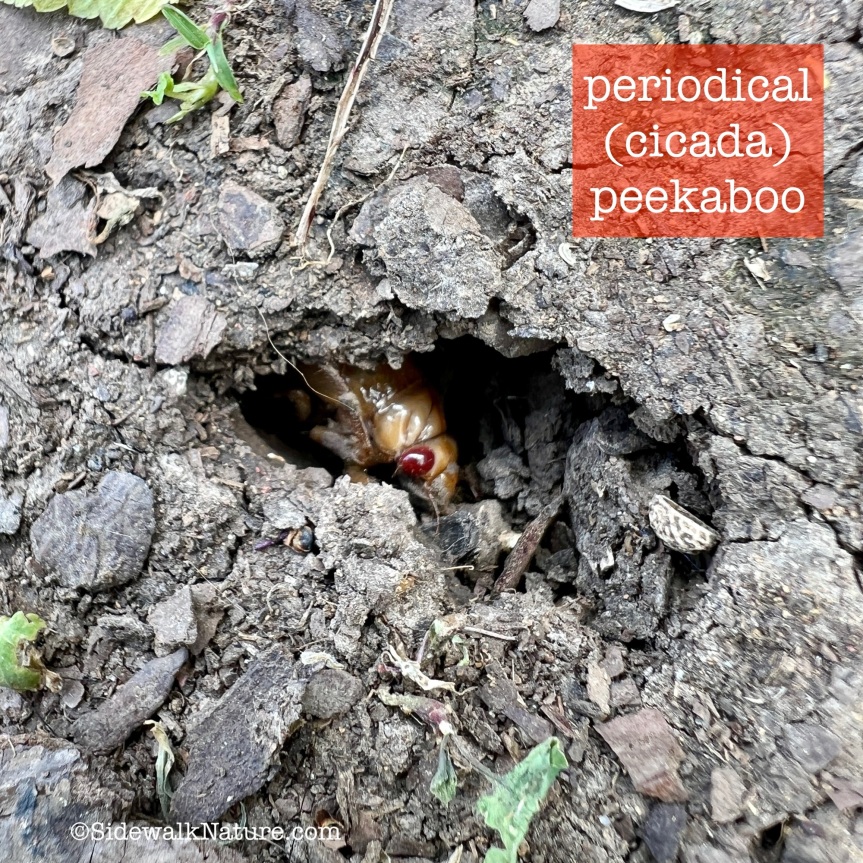
For the above photo, I moved a stone to check on the progress of a nymph. Red eyes, yes, but no black spots, so this one wasn’t quite ready.
Nymphs typically start emerging at dusk, when most predators aren’t active.
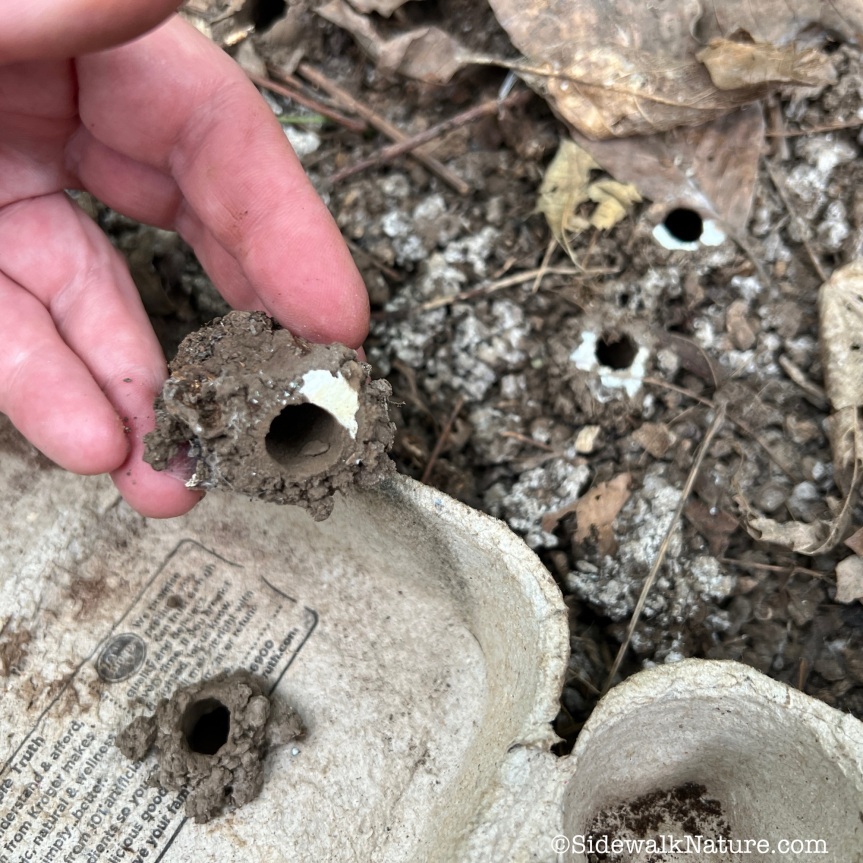
Emergence holes.^ Look how one nymph tunneled through an egg carton near the compost pile. Wet cardboard is no barrier to a cicada.

This one was a late-starter. He was still bumbling around in the bright morning. Or perhaps he wandered all night in search of the perfect place to climb? But daytime means we can see the wing pads really well. (And maybe even those three tiny, simple eyes (ocelli) between the big, compound eyes.)
Emerging nymphs *must* climb a vertical object in order to hang just right, break free of their exoskeleton, and let their bodies and tight-packed wings expand properly. The process can take 2-3 hours, and even longer till they are ready to fly.
When finished, they leave behind the evidence:

(Those white tracheal tubes were attached to spiracles along the side of the nymph.)
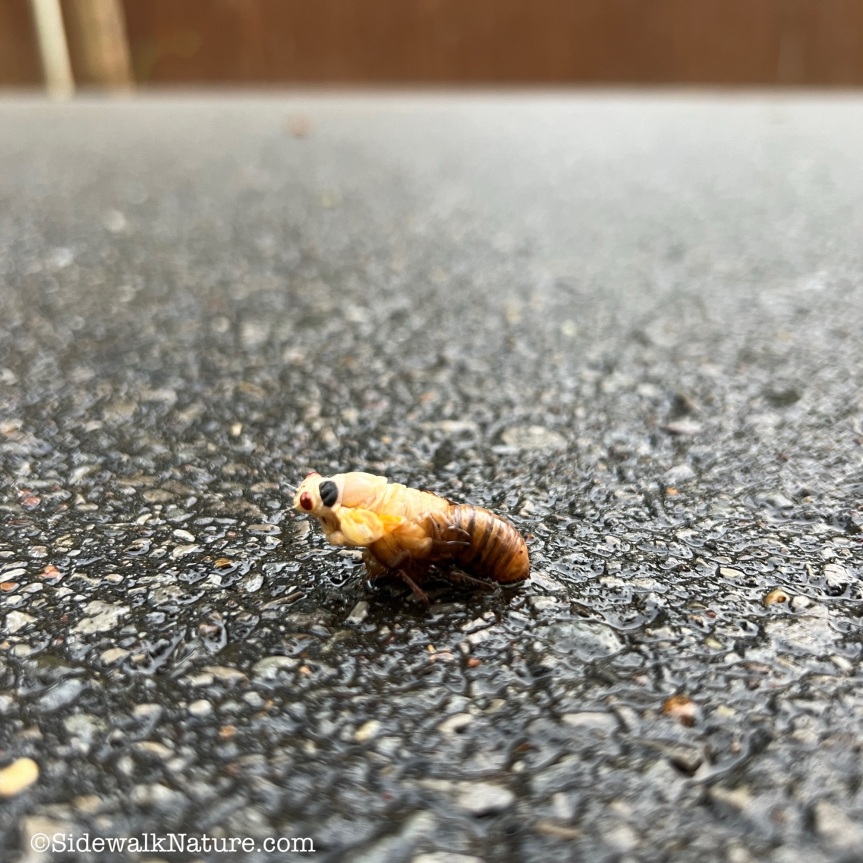
This one didn’t find anything to climb, and would’ve been a goner, but I brought him home and put his feet to a fern.

Utility poles are a lifesaver on a sidewalk.

As are weeds.

And mailbox flowers.

But trash cans are not safe on Trash Day. Those trucks can arrive at just the wrong moment.
How do new adults get from white to black? Some say the weird black spots dissolve throughout the body, some say the black, finished product is a result of oxidation.
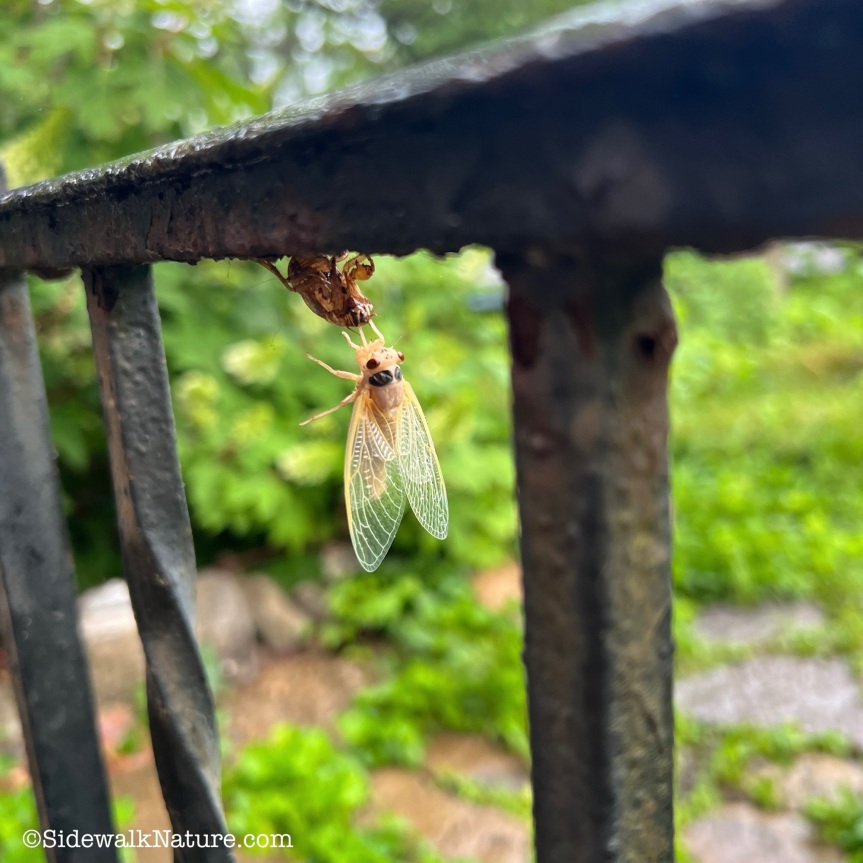
Watching this process must not be missed!
We must be expert witnesses for these “regularly scheduled miracles!”
Here was our first grownup cicada for BroodXIX, just outside our door:
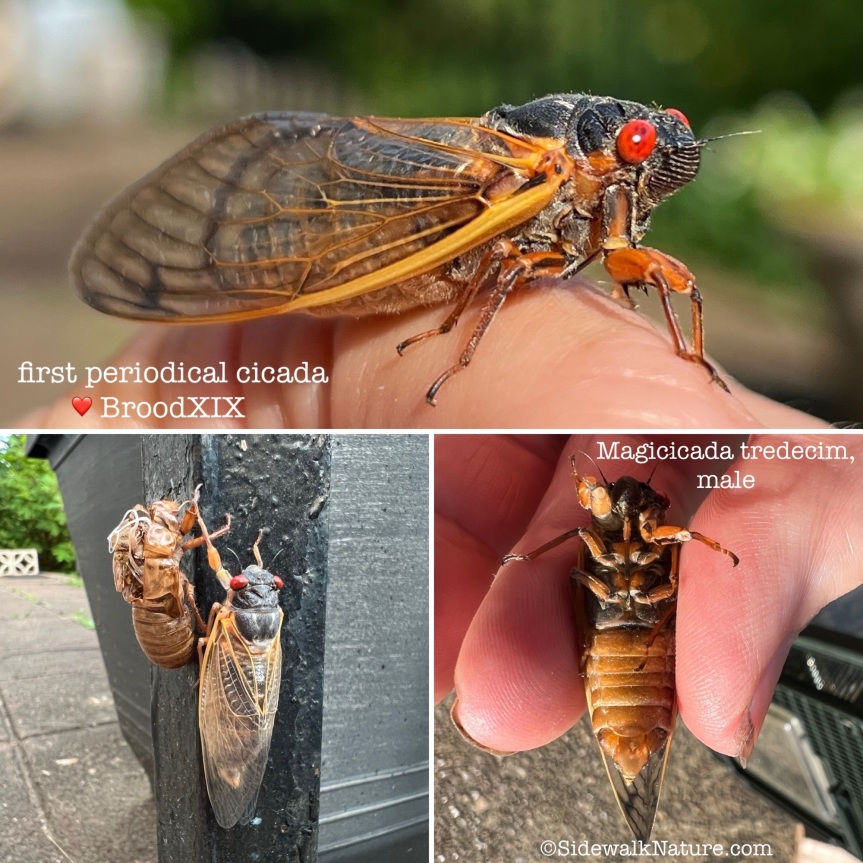
Males emerge first, and predators start gobbling. Males are more … expendable than are egg-laying females.

But the whole point of all this metamorphosis and drama is to grow up and do this:

And then the female can lay eggs in a tree or shrub that will hopefully stay alive for the next 13 years.
Which brings us to EGGS!
Here’s a 24 second video of a female ovipositing in a twig on our peach tree. If you can’t see the video (because you don’t have an Instagram account), I also put it on YouTube, here.


And here’s what’s INSIDE those twigs:


I used a pair of tweezers to pull the twig open just enough to reveal 2 lines of overlapping eggs. (Then tried to close it up again in case the exposure desiccates the eggs?)
The whole stem is in a jar of water for the next 6 weeks, when I hope to see the nymphs hatch and fall to a dark paper collar.
(On the kitchen counter, so I won’t miss it.)

I was told to get rid of the other molts and dead bodies in the kitchen— “Mom, can you pull back on the bugs?”—but no one knows that my innocent little branch in a jar is actually full of more bugs…

I hope to update this post with photos of the eggs hatching into tiny nymphs, whom I will return to the soil where the mom intended.
Meanwhile, most of the nymphs are done emerging in Nashville, but the males are singing LOUD all over town. I hear the chorus by 5:30am on a sunny morning, and it’s always a cumulative pitch of C#.
Check your pitch with a piano or online keyboard, and let me know?
Every now and then I hear the other UFO sound: the weeeee-ohhh / Pharaoh, Pharaoh of a species I’m still trying to figure out based on pitch. They sing from far away, but the pitches are a C# that slides down to an F.
There is still time to watch the dating scene, see females lay eggs, listen to the songs, watch them fly when morning sun hits a tree, record your observations on iNaturalist and Cicada Safari, and spread the word that we are all part of this cicada emergence.
These are our neighbors.
Instead of meeting them with leafblowers, pressure washers, brooms, lawnmowers, pesticides and fear (I’ve seen them all, plenty)
let’s meet them with curiosity and wonder!
And remember, much of Tennessee gets Brood XIV in 2025: our 17-year cicadas…
Links:
–Cicada Mania for all things BroodXIX (and all cicadas). (While browsing, your cursor becomes a cicada)
–CicadaSafari and iNaturalist are both free apps.
-Source for the timing of red eyes and black spots is Dr. Gene Kritsky’s “A Tale of Two Broods: the 2024 Emergence of Periodical Cicadas Broods XIII and XIX” pp. 31-32.
-Black spots: see Cicada Mania’s page “What are the Black Spots on the Back of a Magicicada?” (link), and also the 1911 paper that says oxidation is what changes a white, teneral-stage cicada to black (link).
More
SidewalkNature:
Follow me on Instagram, where my posts are 100% nature, and most of it the Sidewalk kind.
Subscribe to Sidewalk Nature and get an email when I update. I never share your info.
SUBSCRIBE
For folks not on Instagram, I post nature things on Facebook from time to time.
Comment on this post, or if you have a general comment or question, click the Contact page.
Corrections, suggestions, new friends always welcome.
Bio:
Joanna Brichetto is a naturalist and writer in Nashville, the Hackberry-tree capital of the world.
She writes about everyday marvels amid everyday habitat loss at SidewalkNature.com and Instagram (@Jo_Brichetto); and her essays have appeared in Short Reads, Brevity, Ecotone, Fourth Genre, Hippocampus, The Hopper, Flyway, The Common, The Fourth River, and other journals.
Her book is forthcoming from Trinity University Press: This is How a Robin Drinks: Essays on Urban Nature.

If the tree dies and another is replanted immediately, will the cicadas survive on the roots of the newly planted tree? Am worried about an aging tree that is full of cicadas, but may not survive 13 years…
Interesting question! It would depends on many factors. First, I’ve heard from an expert that, according to his observations, the nymphs usually don’t travel more than about one meter from where they dropped onto the soil as hatchlings.
Then there’s the question of how many other trees are nearby. In some cases, one tree’s roots overlap with another tree’s roots, so if one tree dies, adjacent nymphs might be able to transfer allegiance to the living tree’s roots.
But I’m guessing that if a tree dies, and is cut down and the stump gets ground into mulch, then nymphs within range of the grinder would be killed. But, if a new tree is inserted, maybe nymphs within a meter of the new roots, but that had been outside range of stump grinder, could survive??
This is another argument in favor of planting urban trees closer together than we’ve historically done. The famous reason is for roots to interlock and protect each other from blow-overs during storms, but cicada survival is another! Thanks for asking.
absolutely amazing photography. Thank you.
Thank you, Heidi!
Okay – here’s a thought I’ve been bouncing around my brain for a couple of days, and it’s time to infect someone else with this idea. Ready?
Regarding the weee-oh/Pharoah sounding brood – I always hear their spaceship whirring off in the distance, never directly overhead. And even when I travel to that site “off in the distance” to hear the UFOs overhead, they remain off in another distance. Hmmmm…
Could it be an anomaly of sound waves and interference that causes the change in sound?
There. I shared it. Crazy thoughts need to be squished or explored, whichever gains better traction.
Thanks
My crazy thoughts exactly, or near enough. I keep trying to walk toward the source, but the source never gets closer!